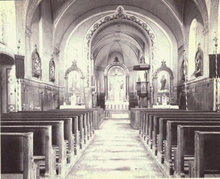Evangelical Lutheran parish church (Vohenstrauß)
The Evangelical Lutheran parish church is a parish church in the Upper Palatinate town of Vohenstrauß in the Evangelical Lutheran dean's office in Weiden .
history
The church, originally consecrated to Our Lady , has been documented since 1417. As a branch church it belonged to the parish Altenstadt near Vohenstrauss . After the Reformation in Vohenstrauß was introduced by Duke Ottheinrich von Pfalz-Neuburg in 1542, the originally Roman Catholic church became the official seat of an Evangelical Lutheran pastor from 1555 and the seat of a superintendent in 1596. After a brief phase of recatholicization during the Counter Reformation (from 1627) in the Thirty Years' War, the church became Protestant again in 1649 ( Confessio Augustana ). From 1652, introduced by Count Palatine Christian August , until 1928 the church was then a simultaneous church . After the dissolution of the Simultaneum through the construction of the Catholic parish church of the Immaculate Conception in Vohenstrauß, the parish church became the sole property of the Protestant community on October 8, 1928.
Church building
Count Palatine Friedrich had the church vaulted in 1594 and built in stone side galleries. In 1595 he bought a positif , d. H. a small organ that was placed on the gallery attached to the choir . Together with his wife, Katharina Sophia von Liegnitz, he donated an altar painting, chalices, altar cloths, etc. a. m. A late Gothic communion chalice is still kept in the Protestant rectory today. After the market fire of 1763, the nave of the church was extended. The interior received a lath vault , but the side galleries were no longer built. The tower was rebuilt on the remains of the wall and got a dome. This church building burned down again in 1839. When it was rebuilt in 1845, the church was given its current appearance. The work was carried out in 1843/44 by master mason Kiener from Nabburg . He extended the building by another yoke to the west and two galleries were built on top of each other on the inside. The tower received a pointed helmet roof . The newly built church was consecrated by clergymen of both denominations. In 1960 the old tower roof was torn down and replaced by a simple tent roof. There are several epitaphs inside and outside the church . The last renovation took place in 1988.
Interior
The interior fittings after the fire of 1839 (pulpit in 1844, high altar and side altars in 1845) were made by the Fürth carpenter Johannes Paulus Haas. In 1888/89 the interior was redesigned in the neo-Romanesque style. The work was carried out by the Mayer'schen Königliche Hof-Kunstanstalt Munich . The altar was made of oak. After the simultaneum was dissolved in 1928, the two side altars and the confessionals were moved to the new Catholic Church. Because of the liturgical reform, they were not set up there, but kept in the attic of the rectory. The Way of the Cross , painted by the Neustadt painter Thaddäus Rabusky , was also removed and left to the Catholic parish.
Today's two high altar paintings, the crib and the Descent from the Cross , were made by Rudolf Schäfer in 1938 . The font , carved from sandstone and granite , which replaced the font from 1845, dates from 1932 .
In 2003 the old side altars were put up for public sale; the evangelical congregation was able to acquire them free of charge and had some of them put up again.
organ
In 1888 the organ from 1845 by the Bittner family of organ builders from Nuremberg was replaced by today's two-manual organ with 17 sounding stops from the Steinmeyer company from Oettingen ; the old work was taken in payment for cannibalization. In 1988 the Otto Hoffmann company from Ostheim vor der Rhön carried out a new intonation and general overhaul of the instrument.
Bells
The small and large bells were melted down from the original three-part bell from the Heinz company from Bayreuth during World War II . The middle bell was preserved, which is now located in the church tower with three other bells.
|
No. |
Casting year |
Foundry, casting location |
inscription |
Chime |
| 1 | 1952 | Bell and art foundry Rincker , Sinn | See, I am with you every day | f sharp 1 |
| 2 | 1845 | Heinz company, Bayreuth | Peace on Earth | a 1 |
| 3 | 1952 | Bell and art foundry Rincker, Sinn | Country, country, country, hear the word of the Lord | h 1 |
| 4th | 1952 | Bell and art foundry Rincker, Sinn | Rejoice that your names are written in heaven | d 2 |
literature
- Constant change of denominations. In: City of Vohenstrauss - 100 years of being a city again. Supplement to The New Day from 7. – 10. June 2012, p. 12.
- Therese Weiß: Evangelical Lutheran City Church Vohenstrauß. In church guides to churches and chapels in the city and large parish Vohenstrauss. (= Streifzüge - contributions to local history and local history of the city and large community Vohenstrauß and the surrounding area, 15th year, 2000, issue 22 ), pp. 16-20.
Web links
Individual evidence
- ↑ Otto Würschinger: Vohenstrauss in old views . European Library, Zartbommel (Netherlands) 1979, picture 30.
- ↑ Simultankirchenweg, Route 9 Vohenstrauß
- ↑ Andreas Weiß: The organs in the churches of the large community Vohenstrauss. In church guides to churches and chapels in the city and large parish Vohenstrauss. (= Streifzüge - contributions to local history and local history of the city and large community Vohenstrauß and the surrounding area, 15th year, 2000, issue 22 ), p. 83.
- ↑ www.oberpfaelzerkulturbund.de: Evangelical Lutheran parish church Vohenstrauss. Retrieved March 27, 2018 .
Coordinates: 49 ° 37 ′ 21.6 " N , 12 ° 20 ′ 29.7" E





